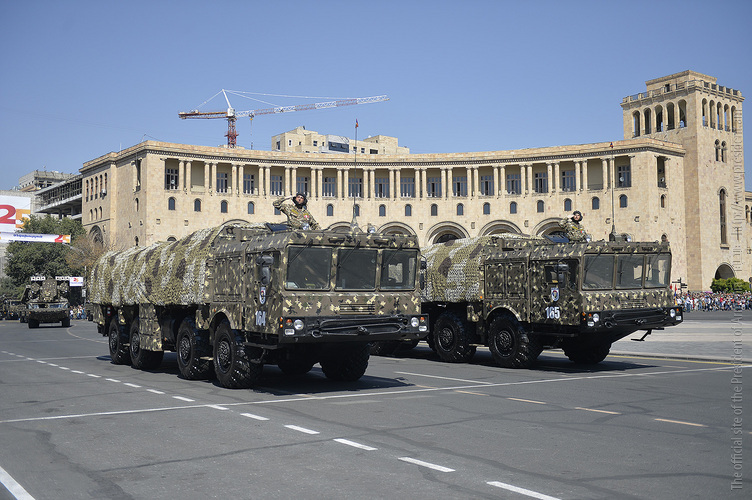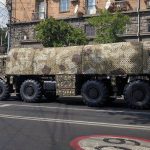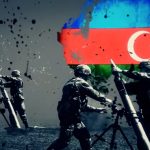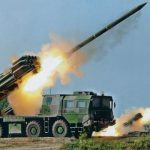- 22 March, 2021
- Military Cooperation

The possibility of using the “Iskander” ballistic missile system by Armenia was widely discussed during the Artsakh war in 2020. In the turmoil of the war, social networks even conducted surveys about this issue. After the war, there were discussions by Armenian former and current political and military authorities about the use of Iskander during the war and its effectiveness. The culmination of these discussions was Prime Minister Nikol Pashinyan’s February 23 statement that the Iskander did not explode or exploded with 10 percent capacity. This article summarizes the public and political debate on this weapon during the recent months.
“Iskander” in Armenia
The first information about the procurement of Iskander by Armenia was received in June 2013, when anonymous sources in the Ministry of Defense of the Republic of Armenia confirmed that several Iskander complexes were located in Armenia. Russian military sources reported in 2015 that negotiations were still ongoing, and “Iskander” complexes would be delivered to Armenia in 2016. In September 2016, during the rehearsal of the military parade dedicated to the 25th anniversary of Armenia’s independence, “Iskander” systems were spotted in the streets of Yerevan for the first time. On September 21, the “Iskander” complexes were presented with great pomp at the military parade taking place in the Republic Square of Yerevan.

Two Iskander systems during the military parade on September 21, 2016
Russian military sources at the time reported that Russia had supplied Armenia with one Iskander squadron with four installations. Back in 2015, Artsrun Hovhannisyan, a representative of the Armenian Ministry of Defense, said that long-range weapons would be purchased with a $ 200 million loan provided by Russia. According to the Stockholm International Peace Research Institute (SIRPI) database, Armenia ordered Iskander missile systems from Russia in 2013, and Russia supplied them to Armenia in 2016. According to SIPRI, Armenia acquired a total of four “Iskander” complexes and 25 missiles, the version in the arsenal of Armenia being “Iskander-E”, which has the ability to hit the target with great accuracy (several meters) at a distance of up to 280 km.
After confirming the fact that “Iskander” is already in Armenia, President Serzh Sargsyan stated that “Iskander” is a forced measure to somehow balance the military situation in our region. “In my opinion, in this case, Iskander is an antidote,” said Sargsyan. Since then, “Iskander” was presented in the Armenian political discourse as a means of restraining Azerbaijan, preventing further aggression against Artsakh and Armenia. For example, in 2018, the “Zinuzh” TV program of the Ministry of Defense presented “Iskander” and “Skad” complexes as “super-powerful weapons that sober up and restrain the adversary.”
Use of “Iskander” in the 2020 war
On the last day of the 2020 war (November 9), a video depicting the launch of Iskander missiles by the Armenian side appeared on the Internet.
Examining the video, the Fact Investigation Platform revealed that the video depicts the launch of “Iskander” missiles.
In early March of this year, an unnamed high-ranking Azeri official told the Middle East Eye website that the Armenian side fired at least one Iskander missile at Baku, but it was hit by an Israeli-made Barak 8 air defense system.
Post-war statements
Days after the end of the war, at the November 19 press conference, answering the question about the use of “Iskander” system, Colonel-General Movses Hakobyan, who was the Head of the Military Control Service of the Armenian Ministry of Defense during the war, said: “I know it was fired, but I will not say in which direction.”
Later, on February 17, former President Serzh Sargsyan announced about the use of the Iskander, claiming that he had reliable information that the Iskander had been used in the last period of the war in the direction of Shushi. Sargsyan also stated that “Iskander” should have been used in the fourth or fifth days of the war, when Azerbaijan had accumulated a huge amount of manpower, military equipment in Horadiz and other parts. “That’s what Iskander is for,” Sargsyan said.
Pashinyan’s statement and reactions in Armenia
The most controversial and the most discussed among the statements about “Iskander” became the statement of Prime Minister Nikol Pashinyan during the February 23 interview. Responding to Serzh Sargsyan’s criticism, Pashinyan stated. “… The rejected person (Serzh Sargsyan, ed.) should know the answers to many questions, not ask questions that he knows the answers to. Maybe they will answer why the “Iskander” did not explode or exploded, for example, with 10% of its capacity.”
The Ministry of Defense did not comment on Pashinyan’s statement, and the Chairman of the National Assembly Committee on Defense and Security Andranik Kocharyan noted: “I also wonder if our procurements of arms during the last 15 years have been right or wrong, whether they are working or not. Can you imagine if Mr. Pashinyan’s suspicions come true?”
Former Minister of Defense Seyran Ohanyan, under whose tenure “Iskander” was acquired, answered Pashinyan: “When received, the Iskander… They delivered it at a high level, and there should be no problem with Iskander.” As for the use of “Iskander” during the war, Ohanyan noted: “My information, like that of every citizen, is from social networks. I do not have that information.” Artak Zakaryan, who held the position of Deputy Minister of Defense in 2017-18, also responded to Pashinyan, noting: “Iskander could not have had technical problems.”
The former Minister of Defense of Artsakh, the former Chief of the General Staff of the Armed Forces of Armenia Movses Hakobyan responded to Pashinyan’s statement as follows: “It is technically possible (“for Iskander “to explode at 10% capacity – ed.)… I am very interested in how they calculated that it exploded with 10% capacity. Did they make any calculation at all? …Because it can only be calculated by the one who has been fired at. I am sure that the man who stated that the Iskander exploded only with 10% capacity, was not fired at, he was not there.” Hakobyan also stated that he was sure that “Iskander” was efficient, that only Azerbaijan could have provided Pashinyan with information about the 10% efficiency of that weapon.
Aram Gabrielyanov, a Russian-Armenian journalist and chairman of the board of directors of Izvestia newspaper, in his turn presented excerpts from a conversation about the use of Iskander with Onik Gasparyan, who served as Chief of General Staff during the war. According to Gabrielyanov, Gasparyan told him that on the third day of the war he had decided to use the Iskander to target two strategic facilities, the Baku-Ceyhan oil pipeline and another target, which Pashinyan had strictly forbidden. “I was only allowed to use the Iskander once to fire at Shushi. I used it. We took advantage of that and were able to bring several tanks into the city. Two days later, I was ordered to leave Shushi and retreat,” Gabrielyanov wrote, quoting Onik Gasparyan.
On February 24, Yerevan Today news website published the response of First Deputy Chief of General Staff General Tiran Khachatryan to Pashinyan’s statement. According to the website, after hearing the question, Khachatryan laughed for a long time, then answered: “Of course, it is not possible… How? Iskander? One shot? 10 percent? I am sorry but this is not a serious conversation (laughs). We shouldn’t say such stuff, and make conclusions. You cannot ask questions about this weapon on the phone, making conclusions with such superficial assessments. It is not serious. I do not know who said what, but it is not possible (laughs again).” The Ministry of Defense issued a statement claiming that the journalist had obviously not fully presented the matter in the article, in fact, distorting the content of the telephone conversation, creating a misunderstanding among the readers, which can be described as an informational provocation. Despite this statement, Tiran Khachatryan was fired the same day. By the way, Tiran Khachatryan was awarded the title of National Hero of Armenia by Pashinyan during the war.
Russia’s reaction and Pashinyan’s step back
Pashinyan’s statement that “Iskander” had some issues was criticized in Russia. Victor Zavarzin, Deputy Chairman of the Russian State Duma Committee on Defense, described Pashinyan’s statement as an “absolute lie.” On February 25, the Russian Ministry of Defense issued a statement denying Pashinyan’s claim that “Iskander” was used during the Artsakh war. “Apparently, the Armenian Prime Minister Mr. Nikol Pashinyan was misled, as a result of which he gave inaccurate information,” the Russian Defense Ministry said in a statement. “The statement also said that the Iskander missile system has been repeatedly tested and successfully used in operations against terrorist groups in Syria, which gives full grounds to claim that the Russian-made Iskander is the best in its class in the world.
After the statement of the Russian Ministry of Defense, Pashinyan took a step back from his previous statement. On March 1, Prime Minister’s spokesperson Mane Gevorgyan said that Pashinyan and Russian President Vladimir Putin had a telephone conversation, and among other issues, they discussed Pashinyan’s statement on the use of the Iskander system by Armenia. “As a result of the combination of the available facts and data, the Prime Minister of Armenia came to the conclusion that he was not properly informed about the matter,” the statement said. Putin’s spokesperson Dmitry Peskov expressed satisfaction on the outcome.
Following this statement, Movses Hakobyan mentioned that he still claims that “Iskander” was fired during the war. “I do not know why the Russian side made such a statement. I cannot comment. I am not an ordinary soldier to publish unverified information,” Hakobyan said.
During a question-and-answer session with the government in the National Assembly on March 3, Arkady Khachatryan, a member of the “Bright Armenia” faction, asked Pashinyan whether “Iskander” was used during the war or not. Deputy Prime Minister Tigran Avinyan answered the question, noting that all the clarifications regarding the statement about “Iskander” were given by the Prime Minister’s spokesperson, that there is nothing else to add.
President of Azerbaijan Ilham Aliyev also commented on the use of “Iskander” by the Armenian side, insisting that during the war Azerbaijan did not register a launch of “Iskander” missiles.
The Russian video as evidence of targeting a hospital in Syria
Responding to Pashinyan’s statement, the Russian Ministry of Defense also presented evidence of Iskander’s effectiveness. A video published as evidence shows how “Iskander” accurately hits the target in Syria. Investigative journalists dealing with Syria located the building in the video, revealing that the target hit was the hospital in the city of Azaz in the north of Syria. The Russian Ministry of Defense did not specify when the video was shot, but the video most likely shows how Azaz Hospital was hit in February 2016. Thus, trying to prove the effectiveness of “Iskander”, Russia inadvertently published the targeting of a hospital by its armed forces, something that Russia had previously denied.
Hovhannes Nazaretyan
Union of Informed Citizens


 Հայ
Հայ Рус
Рус


